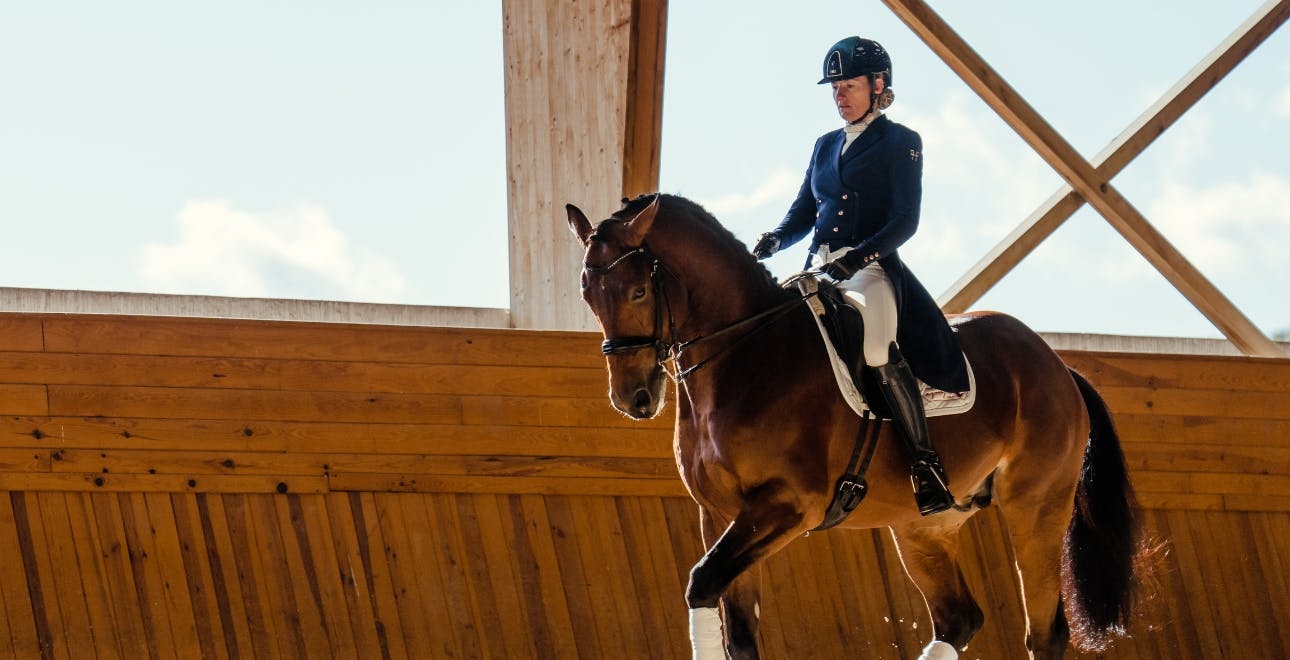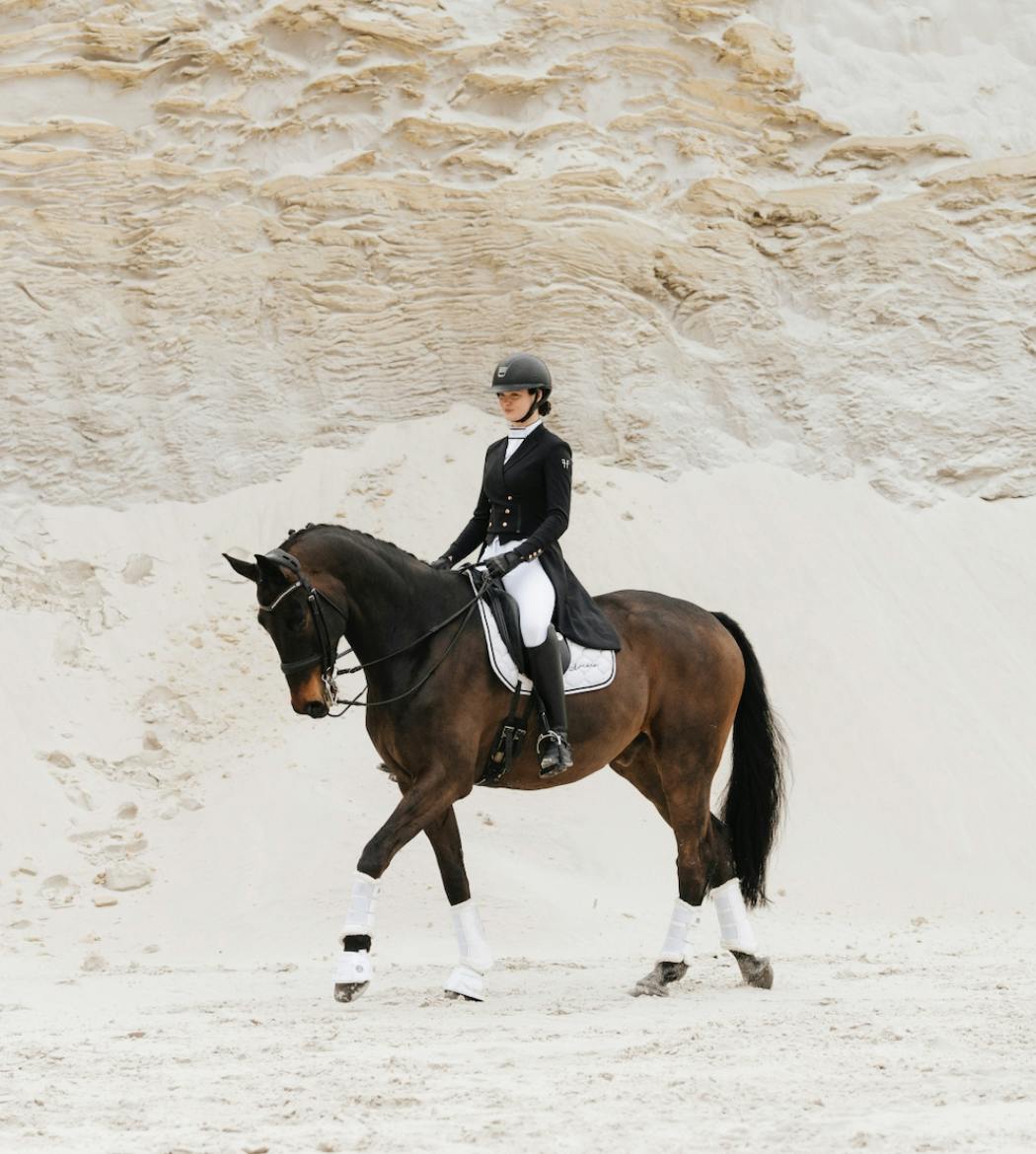X-Perform knee grip riding pants
- $186.90
$267.00
Discover a selection of products designed for dressage rider…

$193.00
Long Frac: dressage jacket for women

As well as dog training, there's also equestrian dressage. Of all the riding disciplines, dressage stands out for its elegant lightness and refinement. What exactly is equestrian dressage? What are its principles? Here's a condensed explanation of this wonderful equestrian art.
Equestrian dressage is to be distinguished from horse breaking. Breaking in a foal means teaching it to be harnessed, to accept the rider on its back and to obey basic commands. Classical dressage techniques, on the other hand, are taught to enable the horse to move elegantly.
The first person to document equestrian dressage was Xenophon, in the 6th century BC, in ancient Greece. The art of horsemanship has evolved over the centuries. Among those who distinguished themselves in this field were Robichon de la Guérinière in France and Steinbrecht in Germany. These two masters sculpted in two distinct but complementary schools:
France, the cradle of equestrian elegance, shines with the École de Saumur.
Germany shines with rigor and discipline, with the Spanish School of Vienna.
Squire François Baucher is also notable. His method, Baucherism, is based on the search for a harmonious relationship between rider and mount. This approach still influences modern equitation.
Horse dressage is based on a scale of progression articulated in six interdependent stages. They are essential to the harmony of the rider-horse relationship. They aim to develop the horse's physical and mental capacities while respecting its balance and health.
Le rythme, la cadence et l'activité naturelle caractérisent les allures du cheval. Le maintien de ces éléments est crucial pour obtenir des allures correctes et équilibrées.
The horse's physical and mental suppleness is the basic acquisition for developing the other stages. It is the result of relaxation and the absence of stiffness, favoring fluid, easy movements.
The contact between the rider's hand and the horse's mouth, established through the reins or bridle, is essential. Complemented by an impeccable seat and position of the aids, it guarantees the horse's natural balance in its movements.
The activity of the hindlegs creates energy that generates impulsion. It is crucial to the expression of elastic gaits. Impulse is both physical propulsion and the horse's mental desire to move forward. A powerful hindquarters and a supple forehand, among other things, fluidify movements. Transitions from straight line to circle or lateral movements are easier.
Like its rider, the horse is more comfortable on one side than the other. Maintaining straightness is a fundamental task. It increases the horse's balance and the symmetry of the contact, by correcting its weaknesses.
Gathering means putting more weight on the hindlegs. It is the ultimate stage to reach, after the acquisition of the others, notably impulsion and straightness. It requires optimum balance and fluid transitions between the different gaits.
Dressage levels progress gradually. From Pony dressage to the Grand National circuit, the Fédération Française d'Équitation caters for amateurs and professionals, children and adults alike. Internationally, the FEI (Fédération Équestre Internationale) is aimed at top-level equestrian sport, as with its Grand Prix. Each level introduces more complex exercises, preparing the rider-horse pair for demanding world equestrian competitions.
Precise techniques aim to establish subtle, harmonious communication between rider and mount. They are used to execute free or compulsory figures in dressage competitions. The result is a performance in which perfect technique is combined with art, like a fairytale equestrian dance.
The essential basis is the transition from one gait to the next. This is followed by figures such as the volte and shoulder in, the change of foot and the curve of the neck. These movements are designed to improve the horse's suppleness, responsiveness and obedience to the rider's aids.
The more advanced the level, the more complex the dressage movements. Figures such as passage, pirouette and piaffe require a high degree of technical mastery. They showcase the dressage horse's strength, flexibility and coordination.
Equestrian dressage, an Olympic discipline, is a fundamental pillar of equestrian competitions. Each dressage routine demands impeccable movements and exemplary complicity between rider and mount. At the heart of equestrian events, these figures are performed at all three gaits: walk, trot and canter. The quality of the dressage and the horse's locomotion are scrutinized by an attentive jury.
The inclusion of dressage in the Olympic Games in 1912 brought classical equitation to the fore. Both free and compulsory, dressage shows the perfect blend of graceful movement and technical excellence. A simple rectangle measuring 60 x 20 meters becomes the stage for a veritable equestrian choreography. Each duet evolves by combining rigor and harmony, both in the sequences and in the way they are held.
During each dressage test, the judges evaluate each movement with the utmost precision. Criteria such as precision of execution, submission of the horse, quality of gaits, impulsion and rider position are taken into account. Each figure, scored from zero to ten points, contributes to the event's final percentage score. The greatest competitions reveal remarkable performances, testifying to the level of excellence achieved in this discipline.
Equestrian dressage goes beyond learning movements. It cultivates a unique complicity and harmony between the horse and rider. This discipline serves as the foundation for all the others, helping to develop the duo's performance.
Based on trust and complicity, dressage creates a subtle bond between rider and mount. With this symbiosis, the horse responds delicately to the rider's aids. Light, precise signals become languages that are understood and executed with finesse.
The art of dressage promotes physical and mental balance in the horse. Its strengthened musculature and perfect composure contribute to clean, fluid movements.
Two things are crucial to getting off to a good start in equestrian dressage: a competent instructor and a mount suited to the discipline and your level.
A good instructor is qualified and experienced, sometimes from a top riding school. Practicing sport riding with a good club instructor gives every amateur an excellent grounding in dressage. Secondly, a club with more qualified and experienced instructors is better suited to dressage and advanced lessons.
Labels and the FFE website are reliable aids for finding an equestrian center or stable. Among them, you'll easily find qualified trainers who give top-level riding lessons.
Certain breeds are renowned for their dressage qualities. These include the Lusitano, the Friesian, the purebred Spanish, the Anglo-Arabian and the Trakehner. Equidae have certain aptitudes that are conducive to maneuverability. Choose a calm horse with an energetic, receptive temperament and a regular, elastic gait. A horse whose parents have a good record of achievement is a good indication of its potential. The most important thing is the complicity between rider and competition horse.
Equestrian dressage is the epitome of elegance and complicity between rider and mount. Deeply rooted in equestrian history, it has become an indisputable Olympic discipline. The practice goes far beyond competition, cultivating a unique relationship between rider and horse. Equestrian dressage sublimates equitation to become an art in motion, fusing technique and passion.
